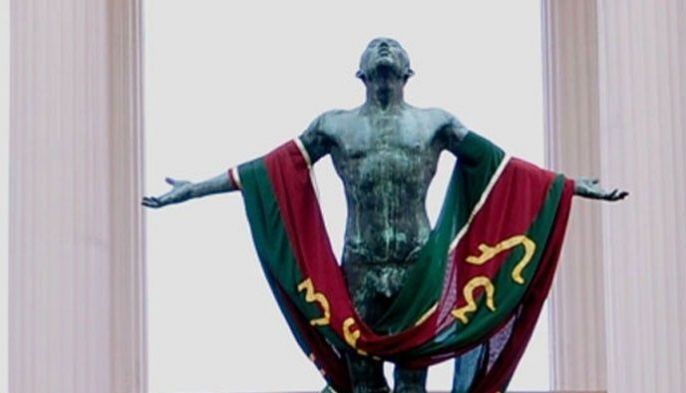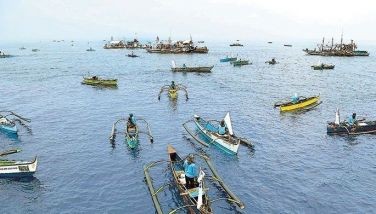Foreign economists see slower growth for RP this year
January 2, 2006 | 12:00am
Foreign economists expect slower economic growth for the Philippines this year due to recurring political problems and the possible impact of high oil prices on the domestic economy.
In their latest reports, four foreign investment houses — DBS Banking Group, Morgan Stanley, Credit Suisse First Boston (CSFB), and United Overseas Bank (UOB) — see the country’s gross domestic product rising 4.5 percent to 5.3 percent in 2006, lower than the government’s projected GDP increase of 5.7 percent to 6.3 percent.
They, however, expect the economy to have grown 4.5 percent to 4.8 percent in 2005, which is within the government forecast range of 4.8 percent to 5.1 percent.
"The main risks to the outlook include a resurgence of global oil prices and repeat of the political turmoil in the third quarter," said DBS Group Research economist Euben Paracuelles in a recent report.
DBS forecasts a 4.8-percent GDP growth in 2005 and a 5.1-percent expansion this year.
President Arroyo survived what could be her worst political crisis in July last year when massive street protests and calls for her ouster peaked with former President Corazon Aquino and Senate President Franklin Drilon asked her to step down over allegations of electoral fraud.
She also survived moves to impeach her in the House of Representatives.
"The emergence of the avian flu outbreak could also significantly hurt growth. The heavy reliance of exports on electronics is an added source of uncertainty, particularly if the current global electronics uptrend fail to be sustained. Recent electronics cycles have become increasingly shorter and shallower," the DBS report said.
CSFB was the most optimistic with a 5.3-percent forecast GDP this year; Morgan Stanley projects a 4.5-percent rise; and UOB sees a 4.7-percent growth.
Albay Rep. Joey Salceda, chairman of the House committee on economic affairs and one of Mrs. Arroyo’s closest advisers, and Socioeconomic Planning Secretary Augusto Santos, however, are unperturbed by the lower growth forecasts.
Salceda said such lower forecasts from investment research houses are "usual as they are invariably and traditionally more conservative than government forecasts."
The forecast of "5.7 percent (GDP) can be easily achieved," he said in a telephone interview. "The risks they mentioned have already been there in 2005 and they have already made their impact."
"By and large will have less than more of the same political (problems) because of the positive impulse of the economy to the political arena. In other words, essentially we have bifurcated our programs before, we have bad politics with good economics but now we’ll see good economy impinging on bad politics for a better environment," Salceda said.
Santos said different firms have various methods of forecasting growth and the government, particularly the National Economic Development Authority, has its own macroeconomic model that it uses to make projections.
"We are sticking to our own forecasts and our track record is not bad," Santos said in a telephone interview. "Our forecasts are more optimistic because we have to show to the people and to the international community that we are confident of our growth and this is not without basis."
He pointed out that all growth projections for the Philippines in the third quarter of last year, even those made by the government and foreign agencies such as the World Bank, were off.
Despite weaker growth forecasts, economists expect respectable growth for the Philippines this year following the implementation of the expanded value added tax (EVAT) to help improve the country’s fiscal condition.
DBS said agricultural output is also set to rise with the absence of the El Niño phenomenon, lifting farm incomes and helping support overall consumption. In the first nine months of 2005, farm output, which accounts for a fifth of GDP, was up 1.7 percent from the year earlier, slower than the 6.58-percent expansion in the period in 2004.
Exports are also expected to improve with the recovery in global electronics demand.
"Government spending should also see an increase from the successful implementation of the EVAT on Nov. 1. The fiscal deficit will likely fall below three percent of GDP (in 2005) before narrowing further to about 2.4 percent of GDP in 2006," DBS said.
CSFB, meanwhile, has upgraded its 2006 GDP growth forecast for the Philippines to 5.3 percent from five percent.
"Abatement of political jitters, implementation of the VAT bills, and resiliency of the economy to oil shocks may explain improved sentiment heading into 2006," CSFB economist Sailesh Jha said.
Jha said the "fiscal dynamics" of the Philippines to show a significant improvement from 2006 to 2010 with the net public debt to GDP ratio falling to 67.1 percent in 2010 from 90.8 percent in 2005.
"This is due to implementation of the VAT bills and very conservative assumptions for trend GDP growth, inflation, expenditure policy, and real exchange rate appreciation," he said.
Jha said he expects the government’s plan to pursue Charter change to move to a parliamentary form of government from the current federal system may emerge as early as the third quarter.
"A plebiscite is due to be held in May, where the populous has to decide whether they want a Charter change. US support for political stability may also be a key factor," he said.
He pointed out that in late October, "an important US senator mentioned support for (Mrs.) Arroyo."
UOB, in a report, said the successful privatization of National Power Corp. (Napocor) will help boost the Philippines’ fiscal condition.
"The fiscal outlook has brightened with the successful implementation of the EVAT on Nov. 1 and planned increase in the VAT and corporate income tax rates... The expected completion of the privatization of Napocor will help to remove uncertainties in the fiscal outlook," UOB said in its latest report.
The government last year moved to the planned sale of about 70 percent of Napocor’s power-generating plants to the first quarter of 2006 from its original end-2005 target. The Power Sector Assets and Liabilities Management (PSALM), a state agency tasked to sell the government’s power generation and transmission assets, has sold only six of more than 30 power plants that have been lined up for sale.
Proceeds from the sale of the Napocor assets were earlier estimated to reach about $2 billion.
UOB also expects the peso to continue its rally against the dollar to hit 52.50 by end 2006, boosted by strong remittance inflows.
The peso closed at 53.09 to a dollar on the last trading day of 2005, almost six percent stronger than the end-2004 level of 56.28. — With Christina Mendez
In their latest reports, four foreign investment houses — DBS Banking Group, Morgan Stanley, Credit Suisse First Boston (CSFB), and United Overseas Bank (UOB) — see the country’s gross domestic product rising 4.5 percent to 5.3 percent in 2006, lower than the government’s projected GDP increase of 5.7 percent to 6.3 percent.
They, however, expect the economy to have grown 4.5 percent to 4.8 percent in 2005, which is within the government forecast range of 4.8 percent to 5.1 percent.
"The main risks to the outlook include a resurgence of global oil prices and repeat of the political turmoil in the third quarter," said DBS Group Research economist Euben Paracuelles in a recent report.
DBS forecasts a 4.8-percent GDP growth in 2005 and a 5.1-percent expansion this year.
President Arroyo survived what could be her worst political crisis in July last year when massive street protests and calls for her ouster peaked with former President Corazon Aquino and Senate President Franklin Drilon asked her to step down over allegations of electoral fraud.
She also survived moves to impeach her in the House of Representatives.
"The emergence of the avian flu outbreak could also significantly hurt growth. The heavy reliance of exports on electronics is an added source of uncertainty, particularly if the current global electronics uptrend fail to be sustained. Recent electronics cycles have become increasingly shorter and shallower," the DBS report said.
CSFB was the most optimistic with a 5.3-percent forecast GDP this year; Morgan Stanley projects a 4.5-percent rise; and UOB sees a 4.7-percent growth.
Albay Rep. Joey Salceda, chairman of the House committee on economic affairs and one of Mrs. Arroyo’s closest advisers, and Socioeconomic Planning Secretary Augusto Santos, however, are unperturbed by the lower growth forecasts.
Salceda said such lower forecasts from investment research houses are "usual as they are invariably and traditionally more conservative than government forecasts."
The forecast of "5.7 percent (GDP) can be easily achieved," he said in a telephone interview. "The risks they mentioned have already been there in 2005 and they have already made their impact."
"By and large will have less than more of the same political (problems) because of the positive impulse of the economy to the political arena. In other words, essentially we have bifurcated our programs before, we have bad politics with good economics but now we’ll see good economy impinging on bad politics for a better environment," Salceda said.
Santos said different firms have various methods of forecasting growth and the government, particularly the National Economic Development Authority, has its own macroeconomic model that it uses to make projections.
"We are sticking to our own forecasts and our track record is not bad," Santos said in a telephone interview. "Our forecasts are more optimistic because we have to show to the people and to the international community that we are confident of our growth and this is not without basis."
He pointed out that all growth projections for the Philippines in the third quarter of last year, even those made by the government and foreign agencies such as the World Bank, were off.
DBS said agricultural output is also set to rise with the absence of the El Niño phenomenon, lifting farm incomes and helping support overall consumption. In the first nine months of 2005, farm output, which accounts for a fifth of GDP, was up 1.7 percent from the year earlier, slower than the 6.58-percent expansion in the period in 2004.
Exports are also expected to improve with the recovery in global electronics demand.
"Government spending should also see an increase from the successful implementation of the EVAT on Nov. 1. The fiscal deficit will likely fall below three percent of GDP (in 2005) before narrowing further to about 2.4 percent of GDP in 2006," DBS said.
CSFB, meanwhile, has upgraded its 2006 GDP growth forecast for the Philippines to 5.3 percent from five percent.
"Abatement of political jitters, implementation of the VAT bills, and resiliency of the economy to oil shocks may explain improved sentiment heading into 2006," CSFB economist Sailesh Jha said.
Jha said the "fiscal dynamics" of the Philippines to show a significant improvement from 2006 to 2010 with the net public debt to GDP ratio falling to 67.1 percent in 2010 from 90.8 percent in 2005.
"This is due to implementation of the VAT bills and very conservative assumptions for trend GDP growth, inflation, expenditure policy, and real exchange rate appreciation," he said.
Jha said he expects the government’s plan to pursue Charter change to move to a parliamentary form of government from the current federal system may emerge as early as the third quarter.
"A plebiscite is due to be held in May, where the populous has to decide whether they want a Charter change. US support for political stability may also be a key factor," he said.
He pointed out that in late October, "an important US senator mentioned support for (Mrs.) Arroyo."
"The fiscal outlook has brightened with the successful implementation of the EVAT on Nov. 1 and planned increase in the VAT and corporate income tax rates... The expected completion of the privatization of Napocor will help to remove uncertainties in the fiscal outlook," UOB said in its latest report.
The government last year moved to the planned sale of about 70 percent of Napocor’s power-generating plants to the first quarter of 2006 from its original end-2005 target. The Power Sector Assets and Liabilities Management (PSALM), a state agency tasked to sell the government’s power generation and transmission assets, has sold only six of more than 30 power plants that have been lined up for sale.
Proceeds from the sale of the Napocor assets were earlier estimated to reach about $2 billion.
UOB also expects the peso to continue its rally against the dollar to hit 52.50 by end 2006, boosted by strong remittance inflows.
The peso closed at 53.09 to a dollar on the last trading day of 2005, almost six percent stronger than the end-2004 level of 56.28. — With Christina Mendez
BrandSpace Articles
<
>
- Latest
- Trending
Trending
Latest
Trending
Latest
Recommended





























